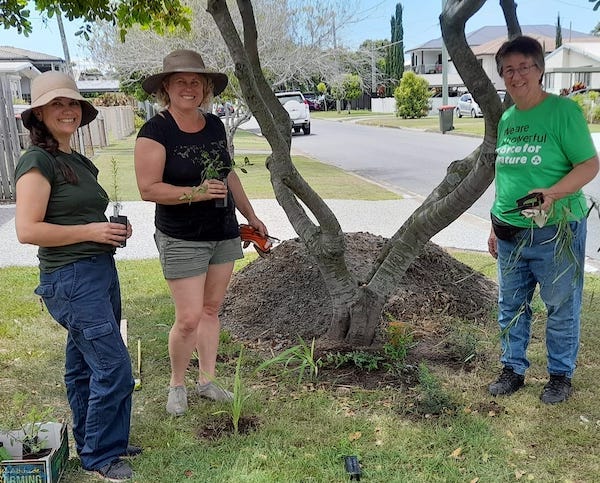Why Native Plants? Why So Slow?
The Banyo Verge Garden Pilot Project working bee at Banyo on Saturday was about a lot more than getting some plants in the ground.
Kira (coordinator of the Banyo Pilot Project), Kylie (it's her verge!), Gayle from the Shady Lanes Project
This is slow gardening, more in the style of bushcare gradually replacing weeds and grass with local native plants, rather than a big landscaping project. We aim for minimal soil disturbance and used small tubestock plants to avoid disturbing the roots of the street tree that was giving us most-welcome shade.
With slow and steady work, all the patches will soon join up and the grass and that odd pile of soil will be gone. The plants will capture leaf litter and increase biodiversity in the soil.
Gardening on the verge is very different to gardening anywhere else. You have to think about where the pedestrians will walk and how the plants will affect them, and how your neighbours will react. There's also how people get out of their cars and making sure that no mulch gets washed into the stormwater drains.
Councils have done a lot of this thinking for you when they come up with their policies and guidelines. It's also a part of the free course Verge Garden Basics – Understanding the Space
Slow gardening also gives you lots of times for getting to know the space and each other. We had some great conversations. For our participants it was seeing theory put into practice. They will talk about their experience and continue the conversations at the the next project event.
Some of the things we touched on:
how native tubestock aren't just cheaper plants, it minimises the pain if a plant is lost
how each resident needs to choose the plants and style of their garden so they love it enough to want to look after it for years to come
how the plants change the way the whole space looks and feels
how going slow gives you lots of time to observe, discuss, and adjust your plans
why we need to take small steps and do what's practical rather than rush in and take on more than we can handle long-term
Do your bit to cool your street
Don't just talk, or click like, or say that's a good idea for other people to do.
Planting all or part of your verge in line with your council's policies is not that hard, especially when you stick to local native plants suited to your climate and soil. Bonus - no more mowing in the hot sun! Request a street tree from your council if there's one missing.
If you don't have a verge, you could help someone else do theirs or join a group project and help with planning, social media or making videos.
Start with the free course, Verge Garden Basics - Understanding the Space
I look forward to hearing about your ideas and initiatives to make our cities and suburbs greener, cooler, and more sustainable.




